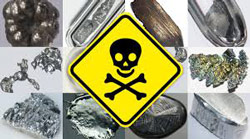|
|
Toxic Metals: Implications for Clinical Practice 
At the end of June the Institute of Optimum Nutrition ran a study day on toxic metals. The day included two presentations by Rachel Nicoll of the BSEM, one an introduction to environmental medicine and one an introduction to toxic metals (see below). These were followed by fascinating case histories from Dr Jenny Goodman and Dr Shideh Pouria. This was the first in a planned series of all day workshops for practitioners; check in with the ION for future workshop subjects. |
|
An introduction to toxic metals. Below are Rachel Nicoll's notes for the presentation which are so comprehensive that we are reproducing them more or less as given. 
1. Toxic Metals: How Are They More Damaging Than Other Toxins?
Moreover...
2. Toxic Metals: A Short-term Therapeutic Benefit As Well!
3. Toxic Metal Deposition
4. Who Is Vulnerable To Metal Toxicity? Everyone, but especially:
Sources of Toxic Metals 1. Foods
2. Iron In Foods And Supplements
3. Cooking And Eating
4. Drinking Water
5. Babies, Toddlers And Children
6. Vaccination: Mercury
7. ‘They Took Out The Mercury And Put In Something Worse!’ www.mercola.com
8. Dentistry
9. Pharmaceuticals
10. Other Important Sources
11. Nanoparticles
Toxic Metals: Effects in the Body Caveat: There are many studies showing these metals have no effect in humans. I am merely showing the results of some that do have an effect. 1. All Metals are Neurotoxins and, particularly as nanoparticles, can cross the Blood Brain Barrier.
2. Endocrine Disruptors
3. Maternal or Foetal Exposure
4. ‘All babies born today, anywhere in the world, have toxic metals in their body.' www.mercola.com
5. Cancer
6. Effect On Immune System
7. Other Conditions
Potential Mechanisms All toxic metals are pro-oxidants, inducing increased ROS production, which damages DNA and protein production and oxidises lipids. Other potential mechanisms include:
How can we protect ourselves and our patients/clients? Prevention Is So Much Easier Than Cure!
And finally...
Rachel Nicoll ? June 2015 First published August 2015
|












